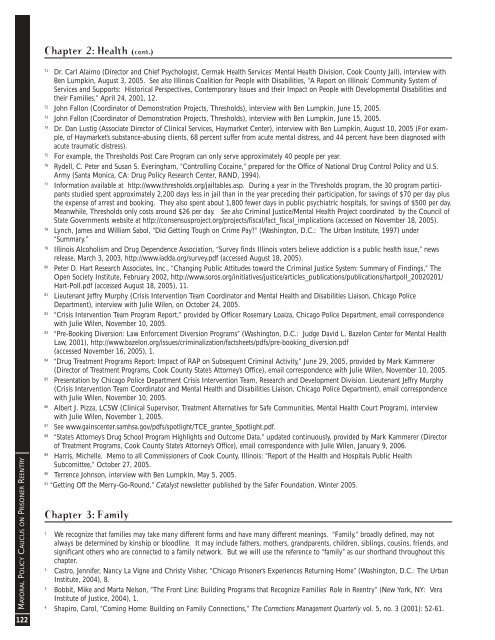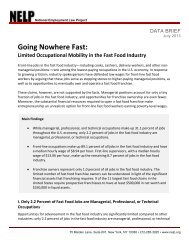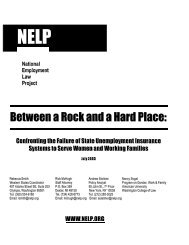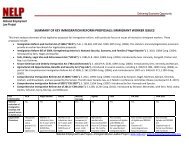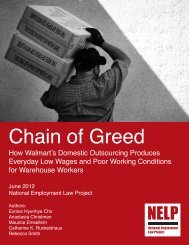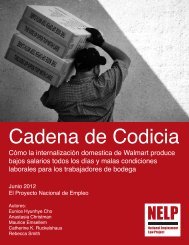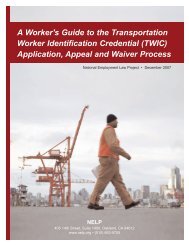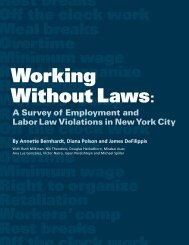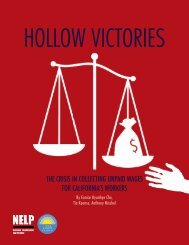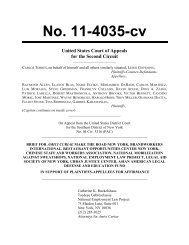Rebuilding Lives. Strengthening Communities.
Rebuilding Lives. Strengthening Communities.
Rebuilding Lives. Strengthening Communities.
Create successful ePaper yourself
Turn your PDF publications into a flip-book with our unique Google optimized e-Paper software.
Chapter 2: Health (cont.)<br />
MAYORAL POLICY CAUCUS ON PRISONER REENTRY<br />
71<br />
Dr. Carl Alaimo (Director and Chief Psychologist, Cermak Health Services’ Mental Health Division, Cook County Jail), interview with<br />
Ben Lumpkin, August 3, 2005. See also Illinois Coalition for People with Disabilities, “A Report on Illinois’ Community System of<br />
Services and Supports: Historical Perspectives, Contemporary Issues and their Impact on People with Developmental Disabilities and<br />
their Families,” April 24, 2001, 12.<br />
72<br />
John Fallon (Coordinator of Demonstration Projects, Thresholds), interview with Ben Lumpkin, June 15, 2005.<br />
73<br />
John Fallon (Coordinator of Demonstration Projects, Thresholds), interview with Ben Lumpkin, June 15, 2005.<br />
74<br />
Dr. Dan Lustig (Associate Director of Clinical Services, Haymarket Center), interview with Ben Lumpkin, August 10, 2005 (For example,<br />
of Haymarket’s substance-abusing clients, 68 percent suffer from acute mental distress, and 44 percent have been diagnosed with<br />
acute traumatic distress).<br />
75<br />
For example, the Thresholds Post Care Program can only serve approximately 40 people per year.<br />
76<br />
Rydell, C. Peter and Susan S. Everingham, “Controlling Cocaine,” prepared for the Office of National Drug Control Policy and U.S.<br />
Army (Santa Monica, CA: Drug Policy Research Center, RAND, 1994).<br />
77<br />
Information available at http://www.thresholds.org/jailtables.asp. During a year in the Thresholds program, the 30 program participants<br />
studied spent approximately 2,200 days less in jail than in the year preceding their participation, for savings of $70 per day plus<br />
the expense of arrest and booking. They also spent about 1,800 fewer days in public psychiatric hospitals, for savings of $500 per day.<br />
Meanwhile, Thresholds only costs around $26 per day. See also Criminal Justice/Mental Health Project coordinated by the Council of<br />
State Governments website at http://consensusproject.org/projects/fiscal/fact_fiscal_implications (accessed on November 18, 2005).<br />
78<br />
Lynch, James and William Sabol, “Did Getting Tough on Crime Pay” (Washington, D.C.: The Urban Institute, 1997) under<br />
“Summary.”<br />
79<br />
Illinois Alcoholism and Drug Dependence Association, “Survey finds Illinois voters believe addiction is a public health issue,” news<br />
release, March 3, 2003, http://www.iadda.org/survey.pdf (accessed August 18, 2005).<br />
80<br />
Peter D. Hart Research Associates, Inc., “Changing Public Attitudes toward the Criminal Justice System: Summary of Findings,” The<br />
Open Society Institute, February 2002, http://www.soros.org/initiatives/justice/articles_publications/publications/hartpoll_20020201/<br />
Hart-Poll.pdf (accessed August 18, 2005), 11.<br />
81<br />
Lieutenant Jeffry Murphy (Crisis Intervention Team Coordinator and Mental Health and Disabilities Liaison, Chicago Police<br />
Department), interview with Julie Wilen, on October 24, 2005.<br />
82<br />
“Crisis Intervention Team Program Report,” provided by Officer Rosemary Loaiza, Chicago Police Department, email correspondence<br />
with Julie Wilen, November 10, 2005.<br />
83<br />
“Pre-Booking Diversion: Law Enforcement Diversion Programs” (Washington, D.C.: Judge David L. Bazelon Center for Mental Health<br />
Law, 2001), http://www.bazelon.org/issues/criminalization/factsheets/pdfs/pre-booking_diversion.pdf<br />
(accessed November 16, 2005), 1.<br />
84<br />
“Drug Treatment Programs Report: Impact of RAP on Subsequent Criminal Activity,” June 29, 2005, provided by Mark Kammerer<br />
(Director of Treatment Programs, Cook County State’s Attorney’s Office), email correspondence with Julie Wilen, November 10, 2005.<br />
85<br />
Presentation by Chicago Police Department Crisis Intervention Team, Research and Development Division. Lieutenant Jeffry Murphy<br />
(Crisis Intervention Team Coordinator and Mental Health and Disabilities Liaison, Chicago Police Department), email correspondence<br />
with Julie Wilen, November 10, 2005.<br />
86<br />
Albert J. Pizza, LCSW (Clinical Supervisor, Treatment Alternatives for Safe <strong>Communities</strong>, Mental Health Court Program), interview<br />
with Julie Wilen, November 1, 2005.<br />
87<br />
See www.gainscenter.samhsa.gov/pdfs/spotlight/TCE_grantee_Spotlight.pdf.<br />
88<br />
“State’s Attorney’s Drug School Program Highlights and Outcome Data,” updated continuously, provided by Mark Kammerer (Director<br />
of Treatment Programs, Cook County State’s Attorney’s Office), email correspondence with Julie Wilen, January 9, 2006.<br />
89<br />
Harris, Michelle. Memo to all Commissioners of Cook County, Illinois: “Report of the Health and Hospitals Public Health<br />
Subcomittee,” October 27, 2005.<br />
90<br />
Terrence Johnson, interview with Ben Lumpkin, May 5, 2005.<br />
91<br />
“Getting Off the Merry-Go-Round,” Catalyst newsletter published by the Safer Foundation, Winter 2005.<br />
Chapter 3: Family<br />
1<br />
We recognize that families may take many different forms and have many different meanings. “Family,” broadly defined, may not<br />
always be determined by kinship or bloodline. It may include fathers, mothers, grandparents, children, siblings, cousins, friends, and<br />
significant others who are connected to a family network. But we will use the reference to “family” as our shorthand throughout this<br />
chapter.<br />
2<br />
Castro, Jennifer, Nancy La Vigne and Christy Visher, “Chicago Prisoner’s Experiences Returning Home” (Washington, D.C.: The Urban<br />
Institute, 2004), 8.<br />
3<br />
Bobbit, Mike and Marta Nelson, “The Front Line: Building Programs that Recognize Families’ Role in Reentry” (New York, NY: Vera<br />
Institute of Justice, 2004), 1.<br />
4<br />
Shapiro, Carol, “Coming Home: Building on Family Connections,” The Corrections Management Quarterly vol. 5, no. 3 (2001): 52-61.<br />
122


